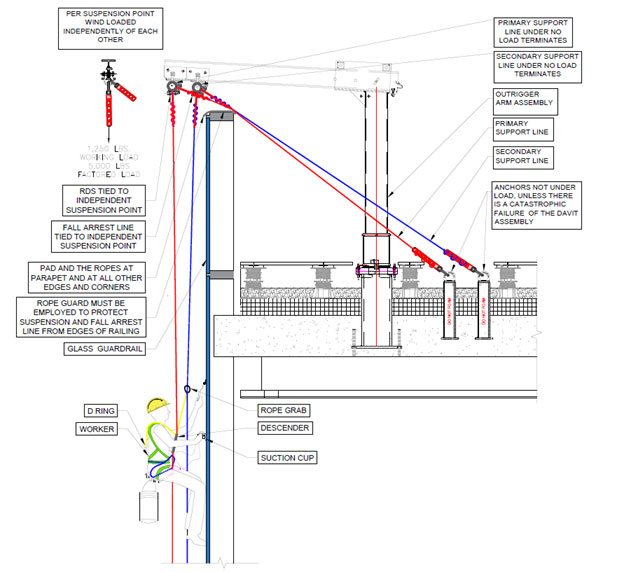- Standard Number:
OSHA requirements are set by statute, standards and regulations. Our interpretation letters explain these requirements and how they apply to particular circumstances, but they cannot create additional employer obligations. This letter constitutes OSHA's interpretation of the requirements discussed. Note that our enforcement guidance may be affected by changes to OSHA rules. Also, from time to time we update our guidance in response to new information. To keep apprised of such developments, you can consult OSHA's website at https://www.osha.gov.
November 10, 2020
Gus Strats
Summit Anchor Company
4507 Metropolitan Court
Suite F
Frederick, Maryland 21704
Dear Mr. Strats:
Thank you for your letter to the Occupational Safety and Health Administration (OSHA), requesting clarification of OSHA’s fall protection requirements when a rope descent system is used with davit booms. In your subsequent correspondence with OSHA, you provided drawings of the davit arrangement with two independent anchors on the same boom, and explained that this rope descent system is used as part of a window washing building system during maintenance operations. This letter constitutes OSHA’s interpretation only of the requirements herein, and may not be applicable to any questions not delineated in your original correspondence. Your paraphrased scenario, question, and our response are below.
Scenario: A roof mounted davit is equipped with two anchors on its boom. A rope descent system consisting of a primary support line (suspension rope) and fall protection line (lifeline) are attached separately to these two independent anchor points on the boom as shown in the attached drawing.
Question: Will attaching both the primary support line and fall protection line to the same davit boom, if attached at different anchors on the boom, be in compliance with OSHA’s fall protection requirements?
Response: Yes. OSHA’s standard at 29 CFR § 1910.140(c)(12) requires that anchorages used to attach to personal fall protection equipment be independent of any anchorage used to suspend employees or platforms on which employees work. In addition, 29 CFR §1910.140(c)(13) requires that anchors used for personal fall protection be capable of supporting at least 5,000 pounds (22.2 kN) for each employee attached; or designed, installed, and used, under the supervision of qualified person, as part of a complete personal fall protection system that maintains a safety factor of at least two.
OSHA’s standard at 29 CFR § 1910.27(b)(2)(vi) requires that employers ensure employees use a separate, independent personal fall arrest system (meeting the requirements of subpart I) when using a rope descent system. Additionally, 29 CFR § 1910.27(b)(1) requires that before any rope descent system is used, the building owner must inform the employer, in writing that the building owner has identified, tested, certified, and maintained each anchorage so it is capable of supporting at least 5,000 pounds (2,268 kg), in any direction, for each employee attached. The information must be based on an annual inspection by a qualified person and certification of each anchorage by a qualified person, as necessary, and at least every 10 years. Additionally, the employer must ensure that no employee uses any anchorage before the employer has obtained written information from the building owner that each anchorage meets the requirements above. The employer must keep the information for the duration of the job.
Therefore, the davit boom described above when used in maintenance operations, equipped with two independent anchor points on the same boom, meets §§ 1910.27(b)(2)(vi) and 1910.140(c)(12), and may be used to attach rope descent and personal fall arrest systems separately. This is permissible as long as the anchorage used for the fall protection line meet § 1910.140(c)(13) requirements and the anchorage used for the rope descent system meet the requirements of § 1910.27(b)(1).
Thank you for your interest in occupational safety and health. We hope you find this information helpful. OSHA’s requirements are set by statute, standards, and regulations. Our letters of interpretation do not create new or additional requirements but rather explain these requirements and how they apply to particular circumstances. This letter constitutes OSHA’s interpretation of the requirements discussed. From time to time, letters are affected when the agency updates a standard, a legal decision impacts a standard, or changes in technology affect the interpretation. To assure that you are using the correct information and guidance, please consult OSHA’s website at www.osha.gov. If you have any questions, please feel free to contact the Directorate of Enforcement Programs at (202) 693-2100.
Sincerely,
Patrick J. Kapust, Acting Director
Directorate of Enforcement Programs


